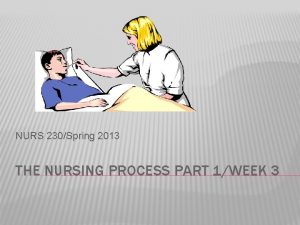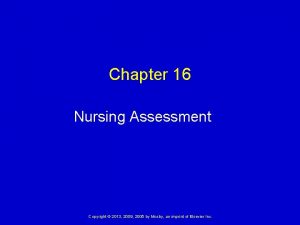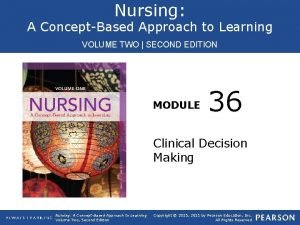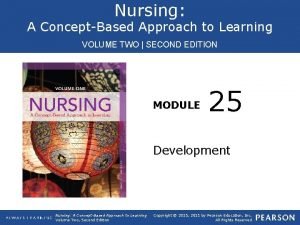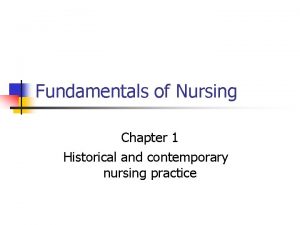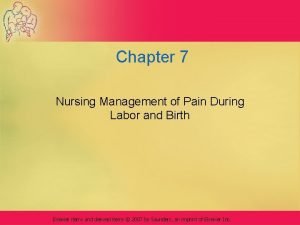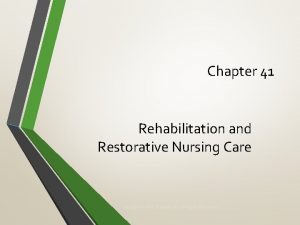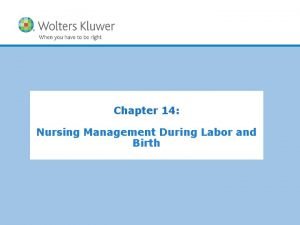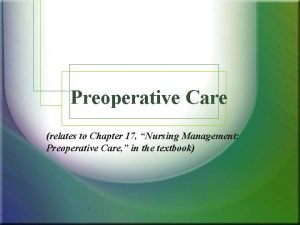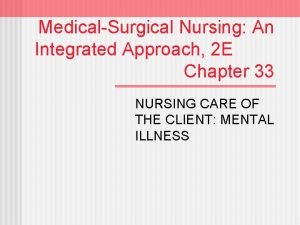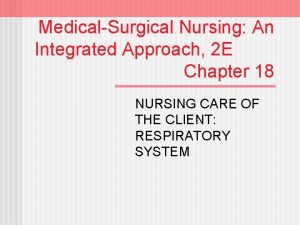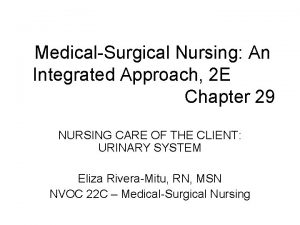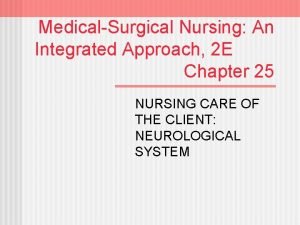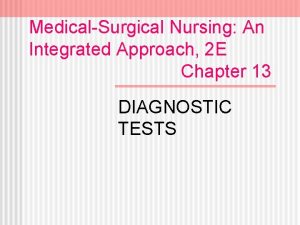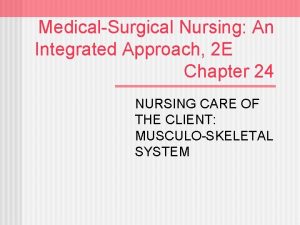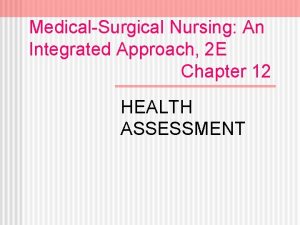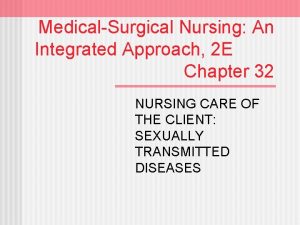MedicalSurgical Nursing An Integrated Approach 2 E Chapter



























- Slides: 27

Medical-Surgical Nursing: An Integrated Approach, 2 E Chapter 9 LOSS, GRIEF, AND DEATH

Loss n Any situation —actual, potential, or perceived —wherein a valued object or person is changed or is no longer accessible to the individual.

Types of Loss Actual (loss of someone or some thing). n Perceived (felt by an individual but not tangible to others, e. g. loss of selfesteem). n Physical (loss of part or aspect of the body). n Psychological (emotional loss, e. g. a woman’s feelings after menopause). n

Categories of Loss n Loss of External Object. n Loss of Familiar Environment. n Loss of Aspect of Self (Physiological or Psychological). n Loss of Significant Other.

Grief n A series of intense physical and psychological responses that occur following a loss. n A normal, necessary, and adaptive response to a loss.

Mourning & Bereavement n Mourning is the period of time during which grief is expressed and resolution and integration of loss occur. n Bereavement is the period of grief following the death of a loved one.

Theories of the Grieving Process Leading theoretical models describing grieving have been devised by: Erich Lindemann n George L. Engle n John Bowlby n William Worden n

Lindemann Theory Erich Lindemann coined the phrase grief work and described typical grief reactions: Somatic distress. n Preoccupation with the image of the deceased. n Guilt. n Hostile reactions. n Loss of patterns of conduct. n

Engle Theory n Three Stages of Mourning n n n Stage I: Shock and Disbelief (disorientation, helplessness, denial). Stage II: Developing Awareness (guilt, sadness, isolation, anger and hostility). Stage III: Restitution and Resolution (bodily symptoms, idealization of the deceased, beginning of coming to terms with loss, establishment of new social patterns and relationships).

Bowlby Theory n Four Stages of Mourning n n Numbness. Yearning and searching. Disorganization and despair. Reorganization.

Worden Theory Four Tasks to Deal with Loss Successfully n n Accept the fact that the loss is real. Experience the emotional pain of grief. Adjust to an environment without the deceased. Reinvest the emotional energy once directed at the deceased into another relationship.

Types of Grief n n Uncomplicated (a grief reaction that normally follows a significant loss). Dysfunctional (intense grief that does not result in reconciliation of feelings). Anticipatory (occurrence of grief work before loss actually occurs). Disenfranchised (grief that is not openly acknowledged, socially sanctioned, or publicly shared, e. g. grief over the loss of a pet).

Factors Affecting Loss and Grief Developmental Stage. n Religious and cultural beliefs. n Relationship with the lost object. n Cause of death. n

Nursing Care of the Grieving Client Nursing care for the grieving follows the standard five-part model: n Assessment. n Nursing Diagnosis. n Planning/Outcome Identification. n Implementation. n Evaluation.

Death & Legal Considerations The Patient Self-Determination Act (PSDA, 1990) was intended to provide individuals with legal means to determine the circumstances under which lifesustaining treatment should or should not be provided to them. n Many states also have a Health Care Surrogate Law, implemented in the absence of advance directives. n

Death & Ethical Considerations Death is often fraught with ethical dilemmas. n Many health care agencies have ethics committees to develop and implement policies to deal with end-of-life issues. n Important distinctions must be made between pain relief and euthanasia. n

Stages of Dying and Death Denial. n Anger. n Bargaining. n Depression. n Acceptance. n

Assessment of the Dying Client and family goals and expectations. n Client’s awareness of terminal nature of the illness. n Availability of support systems. n Current stage of dying. n History of previous positive coping skills. n Client perception of unfinished business to be completed. n

Physiological Needs of the Dying Client n n n n Respirations. Fluids and nutrition. Mouth, eyes, and nose. Mobility. Skin care. Elimination. Comfort. Physical environment.

Hospice A type of care for the terminally ill, founded on the concept of allowing individuals to die with dignity, surrounded by those who love them. n Clients enter hospice care when aggressive medical treatment is no longer an option or when client refuses further medical intervention. n

Signs of Impending Death n n Lungs become unable to provide adequate gas diffusion. Heart and blood vessels become unable to maintain adequate tissue perfusion. The brain ceases to regulate vital centers. Cheyne-Stokes respirations (irregular breathing) and “death rattle” (noisy respirations caused by secretions accumulating in larynx and trachea) signal imminence of death.

Care After Death n n n Treat the body with respect and dignity. Bathe and put a clean gown on the body. Remove dressings and tubes. Place the client in body alignment with extremities straight. Place dentures in the mouth, if client normally wore them. Comb client’s hair.

Legal Aspects Following Death n Autopsy (examination of the body after death by pathologist to ascertain cause of death). n Organ Donation.

Care of the Family Informing the family as to the circumstances of the death. n Providing information about viewing the body. n Offering to contact support people. n Sometimes assisting in decision making regarding a funeral home and removal of the dead person’s belongings. n

Nurse’s Self-Care n Dealing with dying clients is stressful. Nurses must face their grief. n Unresolved grief is called shadow grief. Nurses often carry shadow grief which, if not released, can cause illness and burnout.

Signs of Shadow Grief n n n Loss of energy, spark, joy, and meaning in life. A feeling of being powerless to make a difference. Increased smoking or drinking. Unusual forgetfulness. Constant criticism directed at others. n n Constant inability to get work done. Uncontrolled outbursts of anger. Perception of clients and their families as objects. Surrender of hobbies or interests.

Coping with Shadow Grief n n n Take time to cry with and for clients. Get physical: run, walk, bicycle, play tennis. Ask colleagues to help with tasks; avoid being “Supernurse. ” n n Connect to place of worship; pray. Look for joy in work. Laughter is a great healer. Create a caring circle of friends. Listen to music.
 An integrated approach to business studies
An integrated approach to business studies Lonestar nursing requirements
Lonestar nursing requirements Red rocks community college nursing
Red rocks community college nursing Datagram networks
Datagram networks Cognitive approach vs behavioral approach
Cognitive approach vs behavioral approach Country attractiveness matrix
Country attractiveness matrix Multi approach avoidance conflict
Multi approach avoidance conflict Bandura's reciprocal determinism
Bandura's reciprocal determinism Research approaches definition
Research approaches definition Traditional development approach
Traditional development approach Deep learning approach and surface learning approach
Deep learning approach and surface learning approach The nursing process organizes your approach
The nursing process organizes your approach The nursing process organizes your approach
The nursing process organizes your approach Nursing a concept based approach to learning volume 2
Nursing a concept based approach to learning volume 2 Nursing a concept based approach to learning
Nursing a concept based approach to learning Nursing a concept based approach to learning
Nursing a concept based approach to learning Nursing care models
Nursing care models Nursing management for ocd
Nursing management for ocd Post operative nursing care of cataract
Post operative nursing care of cataract Nursing rationale examples
Nursing rationale examples Nursing process in psychiatric nursing
Nursing process in psychiatric nursing Approach chemistry chalk chapter
Approach chemistry chalk chapter Chapter one the selection of a research approach
Chapter one the selection of a research approach Fundamental of nursing chapter 1
Fundamental of nursing chapter 1 Chapter 7 nursing management of pain during labor and birth
Chapter 7 nursing management of pain during labor and birth Chapter 41 rehabilitation and restorative nursing care
Chapter 41 rehabilitation and restorative nursing care Chapter 14 nursing management during labor and birth
Chapter 14 nursing management during labor and birth Nursing management preoperative care
Nursing management preoperative care











